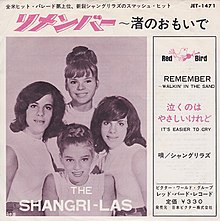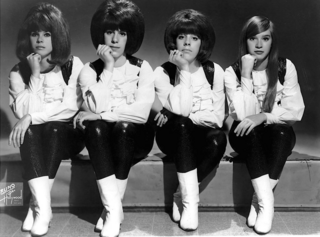
The Shangri-Las were an American girl group of the 1960s, consisting of Mary Weiss, Elizabeth "Betty" Weiss, Marguerite "Marge" Ganser, and Mary Ann Ganser. Between 1964 and 1966 several hit pop songs of theirs documented teen tragedies and melodramas. They continue to be known for their hits "Remember ", "Give Him a Great Big Kiss", and in particular, "Leader of the Pack" which went to #1 in the United States in late 1964.

Mary Louise Weiss was an American singer and interior designer, best known as the lead singer of the Shangri-Las in the 1960s. Their single "Leader of the Pack" went to #1 on the Billboard Hot 100 charts in 1964. She had little involvement in the music scene for decades, returning in 2007 to record her first and only solo album with Norton Records.
George Francis "Shadow" Morton was an American record producer and songwriter best known for his influential work in the 1960s. In particular, he was noted for writing and producing "Remember ", "Leader of the Pack", and other hits for girl group the Shangri-Las.

"I'm Happy Just to Dance with You" is a song written by John Lennon and Paul McCartney and recorded in 1964 by the English rock band the Beatles for the film soundtrack to A Hard Day's Night. Lead vocals are by George Harrison, whose performance in the film marked the first mass media depiction of Harrison singing lead.
The Detergents were an American music group consisting of Ronnie (Ron) Dante, Danny Jordan, and Tommy Wynn. The group's specialty was parody songs, as with their first and best-known single, "Leader of the Laundromat". A spoof of the then-current hit song "Leader of the Pack", "Leader of the Laundromat" became a hit in its own right, reaching the top 20 on the Billboard Hot 100 chart in early 1965.
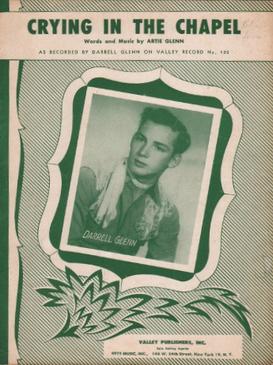
"Crying in the Chapel" is a song written by Artie Glenn and recorded by his son Darrell Glenn. The song was released in 1953 and reached number six on the Billboard chart.
"Wild One" is a dance single by Motown girl group Martha and the Vandellas. Written and produced by William "Mickey" Stevenson and Ivy Jo Hunter. The song was another Top 40 triumph for the group as it reached #34 on Billboard's Hot 100 singles chart and #11 on the Hot R&B singles chart. The backing track for 'Wild one' was an alternative version of the backing track to 'Dancing in the Street'.

"Stay" is a doo-wop song written by Maurice Williams and first recorded in 1960 by Williams with his group the Zodiacs. Commercially successful versions were later also issued by the Hollies, the Four Seasons and Jackson Browne.

"Leader of the Pack" is a song written by George "Shadow" Morton, Jeff Barry, and Ellie Greenwich. It was a number one pop hit in 1964 for the American girl group the Shangri-Las. The single is one of the group's best known songs as well as a popular cultural example of a "teenage tragedy song". The song was covered in 1985 by the heavy metal band Twisted Sister, who had a more modest hit with their version.

"Heartbreaker" is a song performed by American singer Dionne Warwick. It was written by Barry, Robin and Maurice Gibb of the Bee Gees for her 1982 studio album of the same name, while production was helmed by Barry Gibb, Albhy Galuten and Karl Richardson under their production moniker Gibb-Galuten-Richardson. Barry Gibb's backing vocal is heard on the chorus.

"Do Wah Diddy Diddy" is a song written by Jeff Barry and Ellie Greenwich and originally recorded in 1963, as "Do-Wah-Diddy", by the American vocal group the Exciters. Cash Box described the Exciters' version as "a sparkling rocker that bubbles over with coin-catching enthusiasm" and said that the "great lead job is backed by a fabulous instrumental arrangement." It was made internationally famous by the British band Manfred Mann.

"I'll Take You There" is a song written by Al Bell, and originally performed by soul/gospel family band the Staple Singers. The Staple Singers version, produced by Bell, was released on Stax Records in February 1972, and spent a total of 15 weeks on the charts and reached #1 on the Billboard Hot 100. By December 1972, it had sold 2 million units and is ranked as the 19th biggest American hit of 1972. It remains one of the best-selling gospel songs of all time.
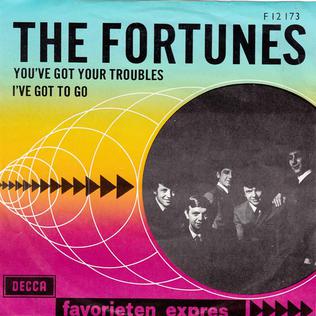
"You've Got Your Troubles" was the inaugural composition by the prolific songwriting team of Roger Cook and Roger Greenaway in 1964. "You've Got Your Troubles" became a number 2 UK hit for the Fortunes in the United Kingdom in August 1965, affording the group international success including a Top Ten ranking in the US. The track was included on the Fortunes' self-titled 1965 debut album release, the group's only album release of the 1960s.
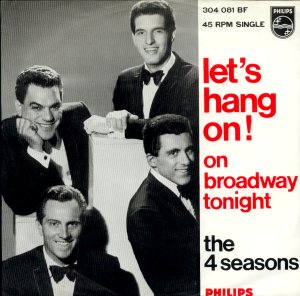
"Let's Hang On!" is a song composed by Bob Crewe, Sandy Linzer, and Denny Randell that was popularized by the Four Seasons in 1965.

"Cherry, Cherry" is a 1966 song written, composed, and recorded by American musician Neil Diamond.

Leader of the Pack is the 1965 debut album by girl group the Shangri-Las. The album was produced to capitalize on the group's breakthrough hits "Remember " and "Leader of the Pack" which had been co-written by Jeff Barry and Ellie Greenwich. After the album's focal track went to number one, The Shangri-Las' style and image had evolved into something tougher and earthier.
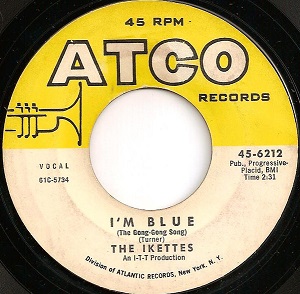
"I'm Blue " is a song written by Ike Turner and recorded by Ike & Tina Turner's backing trio The Ikettes in 1961. In 2017, Billboard ranked the song No. 63 on their list of 100 Greatest Girl Group Songs of All Time.
"It Hurts to Be in Love" is a song written by Howard Greenfield and Helen Miller which was a Top Ten hit in 1964 for Gene Pitney. It was one in a long line of successful "Brill Building Sound" hits created by composers and arrangers working in New York City's Brill Building at 1619 Broadway.
Arthur Marcus "Artie" Ripp is an American music industry executive and record producer.

Shangri-Las-65! is the second album by the Shangri-Las. Released in late 1965, it serves as the follow-up album to Leader of the Pack, which was released earlier in the year.
